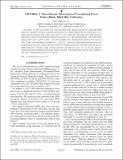GW170814: A Three-Detector Observation of Gravitational Waves from a Binary Black Hole Coalescence
Author(s)
LIGO Scientific Collaboration; Virgo Collaboration; Aggarwal, Nancy; Barsotti, Lisa; Biscans, Sebastien; Buikema, Aaron; Demos, Nicholas; Donovan, Frederick J; Eisenstein, Robert Alan; Essick, Reed Clasey; Evans, Matthew J; Fernandez Galiana, Alvaro-Miguel; Fritschel, Peter K; Gras, Slawomir; Hall, Evan D.; Katzman, W; Kontos, Antonios; Lanza Jr, Robert K; Lynch, Ryan Christopher; MacInnis, Myron E; Martynov, Denis; Mason, Kenneth R; Matichard, Fabrice; Mavalvala, Nergis; McCuller, Lee P; Miller, John; Mittleman, Richard K; Ray Pitambar Mohapatra, Satyanarayan; Shoemaker, David H; Tse, Maggie; Vitale, Salvatore; Weiss, Rainer; Yu, Hang; Yu, Haocun; ... Show more Show less
DownloadPhysRevLett.119.141101.pdf (1.359Mb)
PUBLISHER_CC
Publisher with Creative Commons License
Creative Commons Attribution
Terms of use
Metadata
Show full item recordAbstract
On August 14, 2017 at 10 30:43 UTC, the Advanced Virgo detector and the two Advanced LIGO detectors coherently observed a transient gravitational-wave signal produced by the coalescence of two stellar mass black holes, with a false-alarm rate of 1 in 27 000 years. The signal was observed with a three-detector network matched-filter signal-to-noise ratio of 18. The inferred masses of the initial black holes are 30.5-3.0+5.7M and 25.3-4.2+2.8M (at the 90% credible level). The luminosity distance of the source is 540-210+130 Mpc, corresponding to a redshift of z=0.11-0.04+0.03. A network of three detectors improves the sky localization of the source, reducing the area of the 90% credible region from 1160 deg2 using only the two LIGO detectors to 60 deg2 using all three detectors. For the first time, we can test the nature of gravitational-wave polarizations from the antenna response of the LIGO-Virgo network, thus enabling a new class of phenomenological tests of gravity.
Date issued
2018-05-24Department
Massachusetts Institute of Technology. Department of Physics; LIGO (Observatory : Massachusetts Institute of Technology); MIT Kavli Institute for Astrophysics and Space ResearchJournal
Physical Review Letters
Publisher
American Physical Society (APS)
Citation
Abbott, B. P. et al. “GW170814: A Three-Detector Observation of Gravitational Waves from a Binary Black Hole Coalescence.” Physical Review Letters 119, 14 (October 2017): 141101 © 2017 The Authors
Version: Final published version
ISSN
0031-9007
1079-7114